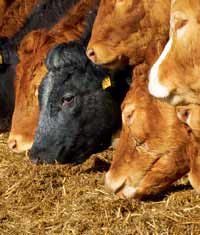Use cereals in feed to capitalise on low prices

Farmers should look to use cereals in their feed rations to make the most of this year’s good availability and low prices, says independent beef and sheep consultant, David Hendy.
“This year, it is better to put cereals on to the hoof rather than selling on to the wheel,” he says.
“Beef prices may be more positive, but with high replacement costs, getting more live weight gain as efficiently as possible should be the aim on any beef farm.”
The key is to add value to your cereals by putting them into your stock. And where possible, use home produced cereals or buy in from local producers, he says.
Good grain quality this year makes cereals an attractive energy source for dairy rations, agrees Mark Voss, Keenan nutritionist. “Higher quality means grain is likely to feed a lot better,” he says.
There are a number of processing options to allow cereal preservation over the winter, says Mr Hendy.
“When grain is 16-20% moisture and rolling is an option, propionic acid can be applied to whole or rolled grain,” he says.
| Beef rations |
|---|
| For help calculating rations this winter, EBLEX will be demonstrating their new ration calculator for beef rations at The Dairy Event and Livestock Show. |
Treating cereals with caustic soda or urea is a good option if there are no rolling facilities available.
For urea treatment, grain needs to be about 28-35% moisture. “When grain is treated too dry, grain may pass through the cattle whole. To prevent this, grain should be soaked with water over night before feeding.”
Caustic treatment allows dairy farmers to feed more kilos of grain while maintaining rumen heath, says Mr Voss. “Caustic-treated grain ferments slower than rolled grain. By feeding a combination of caustic and rolled grain you can provide a balance of slow and fast fermenting grain.”
But, cereals must be introduced to stock gradually to allow the rumento acclimatise and prevent acidosis problems, warns Mr Hendy.
Ideally, in beef cattle, cereals should be introduced at a rate of 0.5kg a head a day, building by 0.5kg a head a day every third day.
Feeding rates will depend on what you are looking to achieve from your stock. “For growing animals, aim for about 2kg of cereal a head a day as part of a balanced ration.”
Finishers should receive about 4-8kg cereal a head a day, depending on the forage and protein in the ration.
“It is essential cereals are balanced with sufficient levels of fibre and protein – a lot of wheat is low in Neutral Detergent Fibre, so it is important this is balanced appropriately,” explains Mr Hendy.
When just using wheat, look at using sugar beet pulp, dried citrus pulp or soya hulls, which are high in energy and Neutral Detergent Fibre. “And I would always suggest including limestone flour at a rate of 100g a head a day to help maintain rumen stability.” Bicarbonate of soda or yeast is also an option if acidosis is a problem.
Dairy farmers must ensure the ration is balanced correctly, agrees Mr Voss. “Feed companies are likely to include more grains in winter blends this year, so when cows are fed in the parlour and given cereals in the main ration, be careful not to over feed grains.”
With this year’s maize looking reasonable, there is the potential to have a lot of starch available. “Be careful not to provide too much starch by balancing winter rations accordingly.”
